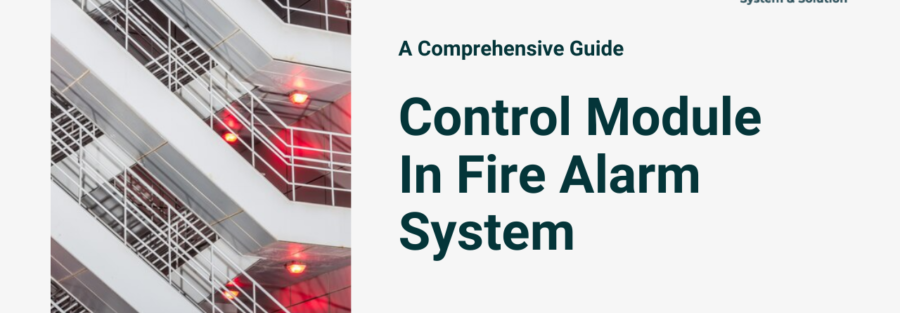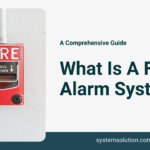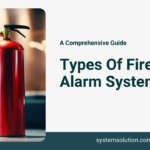A control module in a fire alarm system is an essential device that ensures seamless communication and operation between the fire alarm panel and external systems. It acts as an intermediary, triggering actions like shutting down HVAC systems, activating fire suppression systems, or managing elevator controls during an emergency.
By providing a reliable interface to monitor and control auxiliary devices, the control module fire alarm system enhances efficiency and safety. It ensures timely responses to potential fire hazards, effectively mitigating risks and safeguarding lives and property.
What is a Control Module in a Fire Alarm System?
A control module in a fire alarm system is a critical component designed to manage external devices and ensure proper integration of the system’s functionality.
It serves as an interface that connects and controls various auxiliary devices, such as relays, HVAC systems, elevators, or fire suppression equipment, based on the fire alarm panel’s signals.
By activating or deactivating these devices during emergencies, the control module plays a vital role in enhancing safety and automating responses in fire alarm systems.
Functions of Control Modules:
Control modules serve several key functions within a fire alarm system:
- Monitoring Fire Alarm Devices: Control modules continuously monitor signals from smoke detectors, heat detectors, and other sensors placed throughout the building.
- Activating Notification Appliances: Upon detecting a fire or smoke, control modules activate notification appliances to alert occupants and emergency responders.
- Integration with Building Automation Systems: Modern control modules can integrate with building automation systems, allowing for coordinated responses and enhanced building management during fire emergencies.
Types of Control Modules:
There are different types of control modules tailored to specific functions:
- Input Modules: Receive signals from fire alarm devices and sensors.
- Output Modules: Control notification appliances such as alarms and strobes.
- Relay Modules: Interface between the fire alarm system and other building systems, such as HVAC or access control.
- Addressable Modules: Provide detailed information about the location and status of each connected device, aiding in faster response times during emergencies.
Working Principle:
Control modules communicate with the fire alarm control panel (FACP) through wiring or wireless protocols.
They relay information about the status of connected devices, allowing the FACP to initiate appropriate actions such as sounding alarms and notifying authorities..
Types Of Modules In A Fire Alarm System:
Fire alarm systems utilize various types of modules to ensure seamless integration and efficient functionality. These include monitor modules, which supervise and report the status of external devices like manual call points or tamper switches, and control modules, which manage outputs to auxiliary devices such as sprinklers, elevators, or HVAC systems.
Isolator modules are designed to protect the system by isolating faulted loops, ensuring uninterrupted operation of unaffected zones. Relay modules facilitate the triggering of external devices by sending relay-based commands, while notification appliance circuit (NAC) modules control visual and audible alarms. Together, these modules enhance the fire alarm system’s adaptability and reliability.
Installation of Control Modules:
Proper installation of control modules is crucial for system reliability and compliance with safety standards:
- Placement and Wiring Considerations: Control modules should be strategically located to ensure optimal coverage and minimal wiring distance.
- Compatibility: Ensure compatibility with the specific fire alarm system being installed, considering factors like voltage requirements and communication protocols.
- Safety Standards and Codes: Adhere to local fire codes and regulations governing the installation and operation of fire alarm systems.
Testing and Maintenance:
Regular testing and maintenance are essential to ensure the reliability of control modules:
- Testing Procedures: Conduct regular tests to verify the functionality of control modules and associated devices.
- Troubleshooting: Address common issues such as wiring faults or device malfunctions promptly to maintain system integrity.
- Scheduled Maintenance: Follow manufacturer recommendations for scheduled maintenance to prolong the lifespan of control modules and ensure compliance with safety standards.
Benefits of Using Control Modules in a Fire Alarm System
Control modules in fire alarm systems provide several key benefits, enhancing the system’s functionality and safety features. They allow for seamless integration with auxiliary devices such as sprinklers, HVAC systems, and elevators, enabling automated responses during emergencies.
By managing specific actions, like shutting down ventilation to prevent smoke spread or activating fire suppression systems, control modules improve overall response efficiency. They also simplify system design by reducing wiring complexity and providing centralized control through the fire alarm panel.
Furthermore, control modules enhance reliability by ensuring that external devices respond promptly to fire alarm signals, improving safety and compliance with regulatory standards.
Conclusion:
Control modules are essential components of modern fire alarm systems, ensuring seamless integration and efficient management of auxiliary devices during emergencies.
They enhance the system’s functionality by automating critical responses, such as activating suppression systems or controlling ventilation, ultimately improving safety and reducing risk.
By simplifying operations, increasing reliability, and ensuring compliance with safety standards, control modules play a pivotal role in protecting lives and property. Investing in a fire alarm system equipped with advanced control modules is a proactive step toward comprehensive fire safety.



